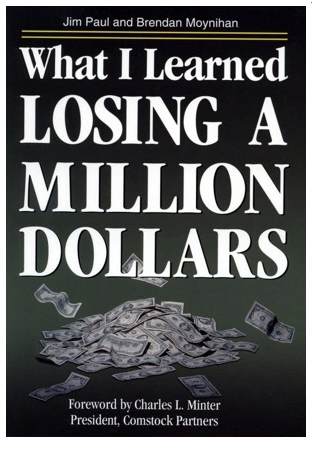What I Learned Losing A Million Dollars
There is a great story that occurred in the business world of the 1960’s. IBM CEO, Tom Watson, called an executive into his office after his divisions venture lost $10 million. The man assumed he was being terminated. Watson told him, “Terminated? Hell, I just spent $10 million educating you. I want to be sure you learned the right lessons.”
There are thousands of books about successful companies, policies, management techniques but virtually none about the lessons from flameout. I highly recommend reading, “What I Learned Losing A Million Dollars” by Jim Paul and Brendon Moynihan specifically because you always learn more from your failures than from your successes. You can get a pretty good insight and powerful education into what does not work when you get a birds’ eye view of those who have had the courage to chronicle the catastrophe of their greatest upsets. This book is a great perspective on FAILURE and how the ego and vanity can lead people to make horrible decisions.
I love to ask traders two very basic questions:
-
What is the best trade you ever made?
-
What is the worst trade you ever made?
When you really dig into these questions they will provide you with insights into the direct causes of success and failure.
This book begins when Jim Paul starts tasting the good life having made several hundred thousand dollars in one day from his commodity futures trading. The author experienced a meteoric rise from a small town in Northern Kentucky to becoming the Governor of the Chicago Mercantile Exchange. The book is two stories in one. The first is a brief history of the author and how he became a successful and arrogant commodity futures broker. The second half of the book outlines the lessons learned from losing more than one million dollars in 1983 trading Soybean Oil futures and reflecting upon the psychology of bad decision making.
On the heels of his greatest success in the markets, Jim Paul was convinced that his meteoric rise would never end. He was convinced that he was invincible and everything that he touched would turn to GOLD. He immediately put his sights on his next conquest, the Soybean Oil market. Convinced that his analysis was correct he preached to anyone who would listen how much money he was going to make next and allowed them “all” to chip in and share in his success. Receptionists, floor traders, phone clerks and brokers were all easily persuaded by Paul’s conviction, and “chipped in” to get in on the action that Paul was a part of. Jim Paul was a guy who as going places.
Everybody is looking for a shortcut to fame and fortune. If you head to your local bookstore you can easily find hundreds of books on how to make more money. What Jim Paul implies is many of the methods are often very specialized or even contradictory. Sir John Templeton tells you to ”diversify” your investments. Then Warren Buffett comes along with his $100 billion net worth and preaches to “concentrate” your investments.
The book points out very clearly that many successful investors/traders have opposing styles and theories on how to succeed, and that they cannot all be right at the same time. But what Jim Paul expands on is the perspective that all of the experts do agree, that the most important aspect of wealth creation is to avoid losing money. The problem with this lesson is that it only becomes self-evident after you have lost money. From this perspective Jim Paul leads the reader to the understanding that there are as many ways to make money in the markets as there are people participating in them, but all losses come from the same few sources.
Let’s look at the legendary advice from Top Trading Titans. Warren Buffett has two rules when it comes to investing. The first? Never lose money. The second: Never forget rule number one.
Wall Street legend Bernard Baruch’s best advice was to “learn how to take losses quickly and cleanly.”
Jim Rogers of Quantum Fund fame built his fortune of $300 million on the following nugget: Don’t lose money.
These investors followed their own paths to the top. What they all had in common was that they knew how to minimize their losses. In other words, they preached that great trading/investing is defensive in nature. Instead of trying to make money, learn how to “not lose money.”
When Paul started rebuilding his empire, he realized that his future success depended on internalizing this lesson. How should loss be understood? What’s the best way of processing it? Most importantly, how can losses be avoided – or at least minimized? We’ll take a look at what Paul learned.
The investment-banking firm Morgan Stanley enjoyed great success in the 1980’s and 1990’s. Their secret was Trade Planning and Risk Management.
Morgan Stanley was known for its forensic attention to detail. Before a trader could implement a trade, both best case and worst-case scenarios were included in their planning process. If you break down trading to its utmost simplicity it is essentially the command, “IF THIS OCCURS THEN THAT.” Applying this process is what all great traders do. It is mistake prevention in action. Where do you get in? Where do you get out? What is your worst-case scenario?
The reason for this attention to detail and painstaking planning is simple. A good plan reduces the likelihood of emotions hijacking the decision-making process later on.
The best traders apply very strict risk management to all of their trading. One great trader I know will take a week off, anytime that he draws his account down more than 3%. It is this defensive nature that allows traders to recognize the truth that the market is going to be here tomorrow, are you?
Jim Paul was convinced that he was going to make a fortune in the Soybean Oil market. He bought and played big. The problem was that right after he purchased, the market sold off and he was immediately down $20,000 in one day.
As the famous psychologist Edward de Bono once observed, “a person will use his thinking to keep himself right.”
No problem thought Paul, he will hold on and eventually the market will return to its senses. Over a period of 3 months Paul lost $1.6 million dollars. In reading the book it is easy to identify with the author and recognize that his identity, status, reputation clouded his decision making. Paul’s identity was very intertwined in this trade. If he lost, he worried he would lose his seat on the Board of Governors at The Chicago Mercantile Exchange. Since he had allowed others to invest with him his reputation with these people was more prominent than the negative price action which was causing huge losses every single day. If you want to improve, you must be content to be thought foolish and stupid. Impressing others is utterly different from being truly impressive.
Paul’s experience shows us all even today 47 years after his experience that our ego, vanity and irrationality will destroy our achievements unless we manage our risk on each and every trade. I am reminded of a comment by a famous engineer who said, “if what you’re doing is really difficult, you’re probably not doing it right!” All ego really is, is our opinions, which we believe to be the absolute truth about how things are.
Traders lose money in the markets either because of analytical errors or because of psychological barriers preventing the application of their analysis. While many analytical methods have validity and make allowances for instances in which they do not work, psychological factors can keep a trader in a losing position, causing them to rationalize the decisions and outcomes which follow.
Stated another way, great pride often comes before a fall.
“Loss” is an unpleasant word. It reminds us of unpleasant things and has very negative connotations.
The same psychological reaction affects traders. But there’s nothing inherently wrong with loss. It is the cost of doing business.
Think of a grocer. They know that a certain percentage of their shelves will spoil and go rotten. That’s a loss, sure, but the “key” is to learn to manage that risk as best they can.
Business is like that. You sometimes lose.
The problem is that due to fear, greed and leverage, traders often take it personally when they lose in the markets. They feel they did something wrong and have trouble accepting and controlling their losses. They trade too large and every blip on the screen has huge significance to them
We all hate making mistakes. That makes it easy to lose sight of the bigger picture. Emotions will often cloud our judgments and make matters worse.
Admitting mistakes is never easy. That’s why traders ignore the evidence and wait for the market to shift. The danger is that it often won’t. And when that happens, an acceptable loss quickly snowballs into something much more serious.
But as anyone who’s been in that situation will tell you, the easiest way to lose money is to fail to have an exit strategy. While this may seem like common-sense it is the wisdom that all the great traders teach.
There are a hundreds of ways to get wealthy, but there’s one thing which everyone who kept their fortune has in common: they know how to minimize losses.
Jim Paul leaves us with this key message:
“Participating in the markets is about making money; it’s about decision making implemented by a plan. It’s actually quite boring waiting for your buy/sell criteria to materialize. The minute it starts getting exciting, you are gambling.”
Well said!
Smart traders need to understand that news cycle stories are often created by marketers and publicists to lure in gullible investors.
But this is where artificial intelligence comes in and why it is so powerful.
A.I., through advanced pattern recognition, analyzing tens of thousands of data points, and crunching millions of computations, finds the highest probability trades and is indispensable in separating fact from fiction.
The power of artificial intelligence is designed to keep you focused on the right side of the market at the right time. Never trading on hope or toxic emotions.
Isaac Newton stated that “a trend in motion, tends to remain in motion until it is stopped.” The risk is too high for opinions or guesswork.
I invite you to check out artificial intelligence at our Next Live Training.
It’s not magic. It’s machine learning.









